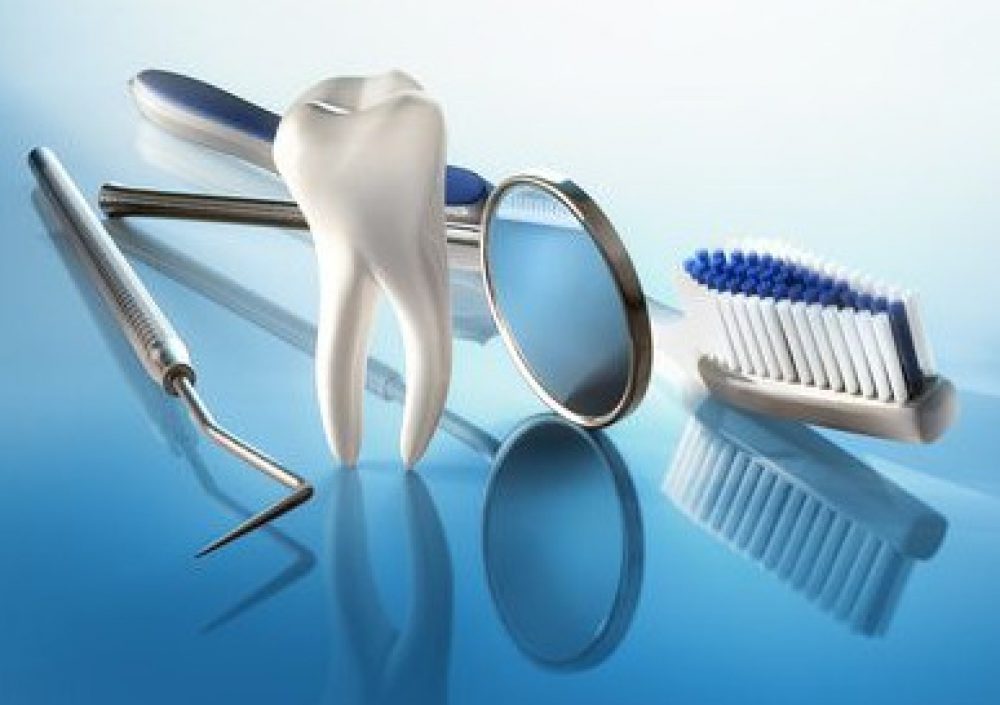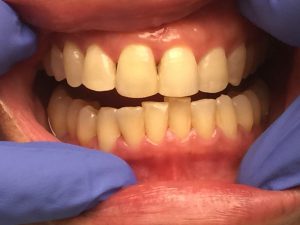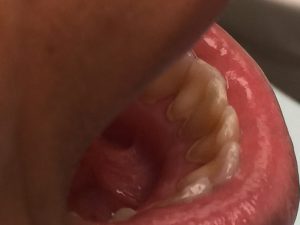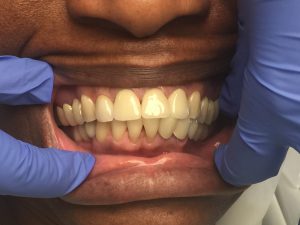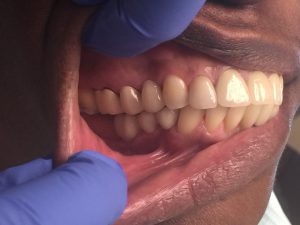Case 1
1. DEMOGRAPHICS
M.B., 27 years old, Heavy/Type II.
2. ASSESSMENT
a. On my patient’s initial visit, I went over his medical history, which is one of the most important assessments in order to plan a safe and effective treatment for all patients. Patient was in good health. However, the patient stated that he was allergic to fish. His vital signs were within normal limits, and BP was 115/82 pulse was 105. No prescription or over the counter (OTC) medication currently being taken. No systemic conditions presented. No premedication needed. Patient is a non-smoker. The patient is ASA1.
3. ORAL PATHOLOGY (Extra and intraoral findings)
Patient had no significant findings during EO/IO assessment.
4. DENTITION
A. Patient has an Angled class I occlusion, 40% overbite and a 4 mm over-jet. The patient presented with slight mandibular anterior crowding. Multiple suspicious carious areas on teeth #’s 2-O, 3-O, 14-O, 15-O, and 32-O. Demineralized areas on teeth #’s 1 and 32. Patient was given a referral for a dental exam for areas of possible caries.
5. PERIODONTAL
Patient had generalized heavy marginal and papillary inflammation and bleeding. Patient was classified as a perio type II with generalized probing depths 4 and 5 mm and localized probing depths 6 mm, especially in the posterior region. Patient had excessive bleeding upon probing. No recession was clinically present.
6. ORAL HYGIENE
Patient was classified as a heavy, based on generalized subgingival calculus on almost every single teeth and localized supragingival calculus mostly lower anterior.
During my self-care assessment, I was able to get to learn more about my patient’s daily home care routine. He brushes twice a day using a hard toothbrush with a scrubbing technique. Patient is not a flosser. The patient’s initial plaque score was very poor (2); most of the biofilm was accumulated on the cervical 1/3 and interproximal.
7. RADIOGRAPHS
Patient’s last set of dental radiographs were taken more than 5 years ago. Patient was exposed to film based FMS on his initial visit. Radiographs revealed generalized subgingival calculus, areas of possible decay on tooth #3, and no bone loss. Instead, the patient had pseudo pockets which explain generalized 4-5 mm and localized 6 mm probing depths. Radiographs correlate with clinical findings. Radiographs are crucial during assessment to help provide an accurate diagnosis and treatment for the patient.
8. Other findings/Time
The patient is a nonsmoker and does not drink alcohol on a regular basis. There were no other factors or significant findings that might affect the patients’ health. The patient hasn’t been to the dentist in more than 5 years and it was very obvious. For someone that hasn’t been to the dentist in more than 5 years, I was not surprised with my findings. A regular dental check-up and cleaning should be every 6 months. Based on his individual needs, I recommended every 3 months.
9. TREATMENT MANAGEMENT
On the first visit, I was able to review the patient’s medical history, take vital sign reading, finish all my assessments, diagnose the patient as a heavy type 2, recommended and discussed the need for 4 quadrants scaling and FMS. The patient was then exposed to film base FMS. Patient’s initial PI was very poor (2). Based on the patient’s initial PI score and where the plaque was located, I recommended and demonstrated modified Bass brushing technique using a manual toothbrush. I also instructed the patient to brush twice a day for two minutes with a soft bristle brush instead of a hard brush. Ultrasonic and hand scaled UR quadrant, heavy bleeding during scaling
On the third visit, I re-evaluated the UR quadrant the area was responding positively to treatment. Patient had a decrease in inflammation and bleeding. Patient stated that he was compliant with home care that was recommended to him. One thing I notice was an accumulation of biofilm on the posterior 1/3 of the teeth. After doing the plaque score for the second time, there was a slight improvement in the patient plaque score (1.7) but clinically I was not happy with the build up of biofilm. Instead of introducing something new, I went over the modified Bass brushing technique and advised him to continue this technique at home. I also recommended reach flosser, since the patient was not a flosser. I believe that this product will be the easiest and more appropriate for the patient. Ultrasonic and hand scaled LR quadrant, teeth #’s 14, 15 and 16, very tenacious calculus and heavy bleeding during scaling. Oraqix was applied for patient comfort.
On the fourth and last visit, I re-evaluated the UR and LR quadrants teeth #’s 14, 15 and 16. I was very happy with the results. The area that was previously scaled was responding positively to treatment. After disclosing the patient for the fourth time, his PI score did improve (1.5). Although it is still poor, overall I could definitely see the improvement. I recommended and demonstrated how to use an electric toothbrush base on my patient individual need. I believe that an electric toothbrush will help him improve the removal of plaque significantly. I also recommended Listerine total care and advised patient to rinse twice a day for 2 minutes. I was able to finish scaling the remaining quadrants which were the UL and LL, polish and applied 5%NaF varnish.There were no medical, social or psychological factors which impacted the treatment for the patient. Patient was referred to DDS for a caries evaluation.
10. EVALUATION
My patient’s overall response to treatment was positive and the outcome was successful for the most part. Re-evaluating areas that were previously scaled was responding positively to treatment; decreased bleeding and inflammation. Although I saw improvement in the patient’s soft tissue and plaque score, I was still concerned with the biofilm accumulation present on the cervical 1/3. I asked him if he was incorporating the technique that was recommended and demonstrated at home and he said yes. I then asked him to demonstrate the technique for me. His demonstration was good. I continued to explain to him what plaque is and what could eventually happen if it is not removed frequently. Each visit, instead of just recommending and demonstrating something new, I would continue to work with him on mastering the brushing technique and keep educating him about plaque control. Each visit I was able to see significant improvements in the patient’s PI score. I was able to see great improvement in his gingiva after re-evaluating each scaled quadrants. There were no additional interventions incorporated for home care. This patient has a three-month recare.
11. REFLECTION
I was able to accomplish everything that was planned for my patient, both educational and mechanical. My strength for this case was hand and ultrasonic scaling. I was able to remove all the calculus that was present on teeth surfaces. This was a tough case because the patient had very tenacious calculus and heavy bleeding, but I was very proud of what I accomplished. however, although I saw improvement in the patient plaque score, soft tissue and decrease inflammation in the areas that were scaled, but biofilm accumulation was still present. I’m concerned that all the progress that was made will eventually go back to where we started. I did my part both educationally, mechanically and emphasize the important of maintaining a good oral health. I hope the patient continue to do his part for a better overall health.
Case 2
54 year old, African American female presents with BP-125/82 and P-74. Patient was in good health, no medication no systemic condition, and no allergy. EO/IO was within normal limits. Multiple missing teeth, due to previous periodontal disease. Multiple bridge work and implant placement. Generalized 1-4mm probing depths, with slight bleeding upon probing. Localized recession 1-2mm on lower anterior. The patient had generalized slight bleeding and gingival inflammation. Localize sub and supra gingival calculus. Patient was classified as a medium type I. Base on the patient individual need, I recommended an electric toothbrush and demonstrated brushing technique. I also recommended water floss, due to multiple bridge work and implants. Advised Patient to brush twice a day for two minutes and use the water floss daily. I then ultrasonic and hand scaled all 4 quadrants, slight bleeding during scaling. I recommended a 3 month recur length.
As a dental hygiene I come across many different cases. This patient had multiple bridge work and implants present, so I had to make some adjustment with the way I treat this patient. When a patient have this many dental work done it can be very challenging to maintain. But this patient was doing a good job with home care which I was very happy to see.
